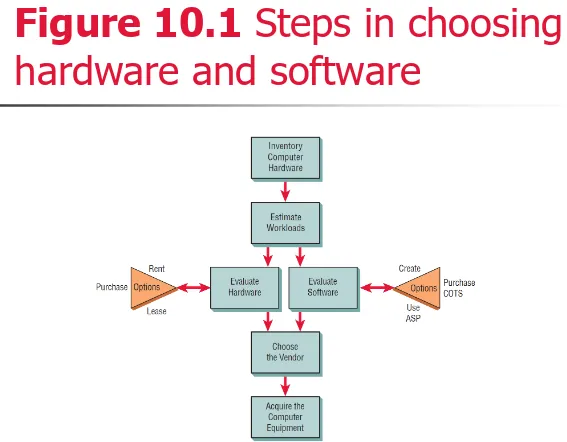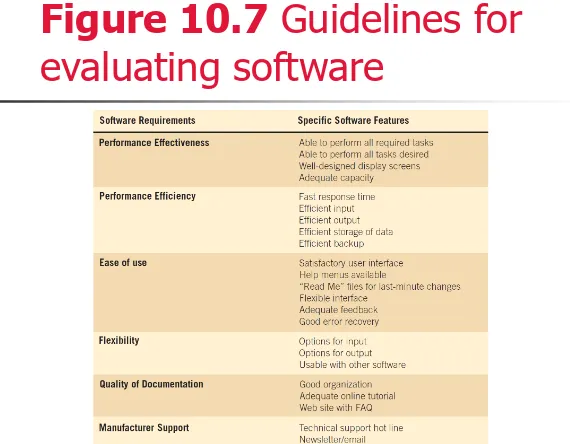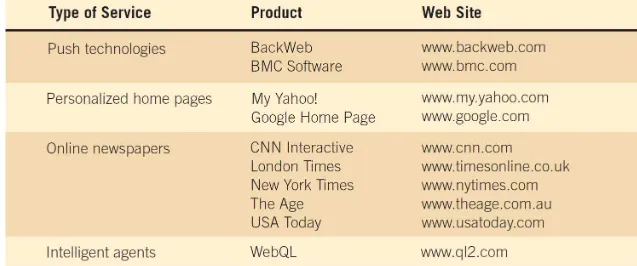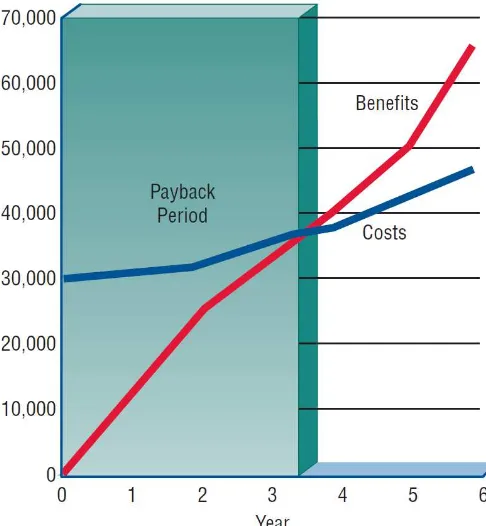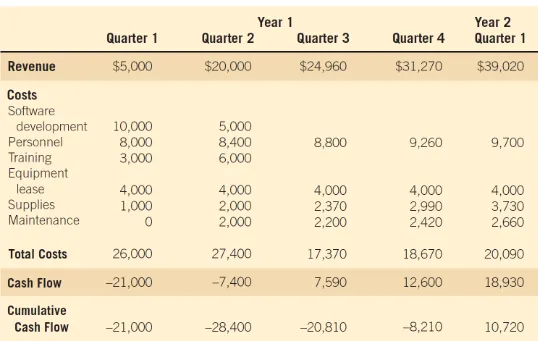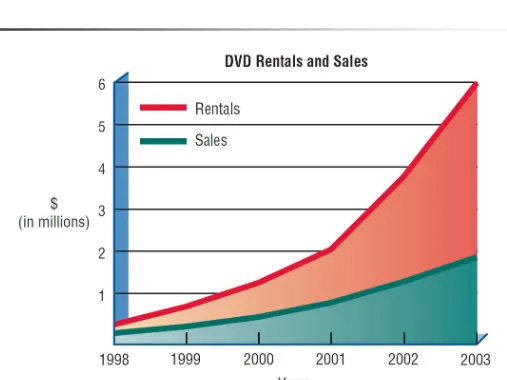CCJ-123-DASAR
PENGEMBANGAN PERANGKAT
LUNAK (PERTEMUAN-5)
Dosen Pengampu :
5165-Kundang K Juman,
Preparing the Systems
Proposal
Systems Analysis and Design, 7e Kendall & Kendall
10
Kendall & Kendall 10-3
Learning Objectives
• Inventory and appraise current and proposed hardware and software and the way it
supports human interactions with technology
• Evaluate software by addressing the trade-offs among creating custom software,
purchasing COTS software, and outsourcing to an application service provider
Kendall & Kendall 10-4
Learning Objectives (Continued)
• Forecast tangible and intangible costs and benefits, and perform a
cost-benefit analysis using a number of methods
• Professionally write and present an effective systems proposal,
Kendall & Kendall 10-5
Systems Proposal
• A distillation of all that the system analyst has learned about users, the business, and about what is needed to improve its performance
• Systematic methods to:
• Acquire hardware and software
• Identify and forecast costs and benefits
Kendall & Kendall 10-6
Major Topics
• Ascertaining hardware/software needs
• Tangible and intangible costs and benefits
• Systems proposal
Kendall & Kendall 10-7
Ascertaining Hardware and
Software Needs
Steps used to determine hardware and software needs:
• Inventory computer hardware currently available
• Estimate current and future system workloads
• Evaluate available hardware and software
• Choose the vendor
Kendall & Kendall 10-8
Kendall & Kendall 10-9
Inventorying Computer Hardware
• Type of equipment
• Operation status of the equipment
• Estimated age of equipment
• Projected life of equipment
• Physical location of equipment
• Department or person responsible for equipment
Kendall & Kendall 10-10
Estimating Workloads
• Systems analysts formulate numbers that represent both current and
projected workloads for the system so that any hardware obtained will possess the capability to handle current and
Kendall & Kendall 10-11
Kendall & Kendall 10-12
Evaluating Hardware
• Time required for average transactions
• Total volume capacity of the system
• Idle time of the CPU or network
Kendall & Kendall 10-13
People That Evaluate
Hardware
• Management
• Users
Kendall & Kendall 10-14
Acquisition of Computer
Equipment
• Buying
• Leasing
Kendall & Kendall 10-15
Kendall & Kendall 10-16
Kendall & Kendall 10-17
Kendall & Kendall 10-18
Evaluating Vendor Support
• Hardware support
• Software support
• Installation and training support
Kendall & Kendall 10-19
Other Considerations
• Possibility of adding on to the system
• Interfacing with equipment from other vendors
• Adding more memory
Kendall & Kendall 10-20
Software Alternatives
• Created custom software
• Purchased as COTS (commercial off-the-shelf) software
Kendall & Kendall 10-21
Kendall & Kendall 10-22
Kendall & Kendall 10-23
Kendall & Kendall 10-24
Software Evaluation
• Performance effectiveness
• Performance efficiency
• Ease of use
• Flexibility
• Quality of documentation
Kendall & Kendall 10-25
Kendall & Kendall 10-26
Decision Support Tools
• AHP and other multiple-criteria software
• Expert systems and neural nets
• Recommendation systems
Kendall & Kendall 10-27
AHP and Other Multiple-criteria
Software
• Multiple-Criteria
• The objective
• Alternatives
• Criteria
• priority
Kendall & Kendall 10-28
Expert Systems and Neural Nets
• Expert systems are rule-based
reasoning systems developed around an expert in the field
• Neural nets are developed by solving a number of problems of one type and
Kendall & Kendall 10-29
Recommendation Systems
• Software and database systems that reduce the number of alternatives by ranking, counting, or some other
method
• Does not depend on numeric weights
Kendall & Kendall 10-30
Kendall & Kendall 10-31
Identifying and Forecasting
Costs and Benefits
• Judgment methods
• Estimates from the sales force
• Surveys to estimate customer demand
• Delphi studies
• Creating scenarios
Kendall & Kendall 10-32
Identifying and Forecasting Costs
and Benefits (Continued)
• If historical data are available
• Conditional
• There is an association among variables in the model
• Unconditional
Kendall & Kendall 10-33
Estimation of Trends
• Graphical judgment
• The method of least squares
Kendall & Kendall 10-34
Graphical Judgment
• Looking at a graph and estimating by freehand an extension of a line or curve
• Disadvantage
• The extension of the line may depend too much on individual judgment
• Advantage
Kendall & Kendall 10-35
The Method of Least Squares
• Find the best-fitting line by minimizing the sum of the deviations from the line
• Once the best-fitting line is found, it can be extended to forecast what will
Kendall & Kendall 10-36
Moving Averages
• Calculate the arithmetic mean of data from groups or periods, then calculate the next arithmetic mean by discarding the oldest
period’s data and adding the next period • Advantage
• Useful for its smoothing ability
• Disadvantage
Kendall & Kendall 10-37
Kendall & Kendall 10-38
Identifying Benefits and Costs
• Tangible
Kendall & Kendall 10-39
Tangible Benefits
• Advantages measurable in dollars that accrue to the organization through the use of the
information system
• Examples:
• Increase in the speed of processing
• Access to otherwise inaccessible information
• Access to information on a more timely basis
• The advantage of the computer’s superior
calculating power
Kendall & Kendall 10-40
Intangible Benefits
• Intangible benefits are benefits from use of the information system that are difficult to measure
• Examples:
• Improving the decision-making process
• Enhancing accuracy
• Becoming more competitive in customer service
• Maintaining a good business image
Kendall & Kendall 10-41
Tangible Costs
• Those that can be accurately projected by
systems analysts and the business’
accounting personnel
• Examples:
• Cost of equipment
• Cost of resources
• Cost of systems analysts' time
• Cost of programmers’ time
Kendall & Kendall 10-42
Intangible Costs
• Those that are difficult to estimate, and may not be known
• Examples:
• Losing a competitive edge
• Losing the reputation for being first
• Declining company image
Kendall & Kendall 10-43
Comparing Costs and Benefits
• Break-even analysis
• Payback
• Cash-flow analysis
Kendall & Kendall 10-44
Break-Even Analysis
• The point at which the total cost of the current system and the proposed system intersect
• Useful when a business is growing and volume is a key variable in costs
• Disadvantage
• Benefits are assumed to remain the same
• Advantage
• Can determine how long it will take for the
Kendall & Kendall 10-46
Cash-Flow Analysis
• Examines the direction, size, and
pattern of cash flow that is associated with the proposed information system
• Determine when cash outlays and
Kendall & Kendall 10-47
Kendall & Kendall 10-48
Present Value Analysis
• Way to assess all the economic outlays and revenues of the information system over its economic life, and to compare costs today with future costs and
today's benefits with future benefits
• Presents the time value of the
Kendall & Kendall 10-49
Kendall & Kendall 10-50
Guidelines for Analysis
• Use break-even analysis if the project needs to be justified in terms of cost, not benefits
• Use payback when the improved tangible benefits form a convincing argument for the proposed
system
• Use cash-flow analysis when the project is expensive, relative to the size of the company
Kendall & Kendall 10-51
The Systems Proposal
• Cover letter
• Title page of project
• Table of contents
• Executive summary
• Outline of systems study with appropriate documentation
• Detailed results of the systems study
• Systems alternatives
• Systems analysts recommendations
• Summary
Kendall & Kendall 10-52
Using Figures for Effective
Communication
• Effective use of tables
Kendall & Kendall 10-53
Effective Use of Tables
• Integrate into the body of the proposal
• Try to fit the entire table vertically on a single page
• Number and title the table at the top of the page
• Label each row and column
• Use a boxed table if room permits
Kendall & Kendall 10-54
Kendall & Kendall 10-55
Effective Use of Graphs
• Choose a style of graph that communicates your intended meaning well
• Integrate the graph into the body of the proposal
• Give the graph a sequential figure number and a meaningful title
• Label each axis, and any lines, columns, bars, or pieces of the pie on the graph
Kendall & Kendall 10-56
Types of Graphs
• Line graphs
• Column charts
• Bar charts
Kendall & Kendall 10-57
Line Graphs
• Used to show change over time
• Changes of up to five variables on a single graph
Kendall & Kendall 10-58
Kendall & Kendall 10-59
Column Charts
• Can depict a comparison between two or more variables over time
• Used more often to compare different variables at a particular point in time
Kendall & Kendall 10-61
Special Forms of Column Charts
• 100 percent stacked column chart
• Shows the relationship between variables that makes up 100 percent of an entity
• Deviation Column Chart
Kendall & Kendall 10-62
Bar Charts
• Used to show one or more variables within certain classes or categories during a specific time period
• Sorted or organized
• Alphabetical
• Numerical
• Geographical
• Progressive order
Kendall & Kendall 10-63
Pie Charts
• Used to show how 100 percent of a commodity is divided at a particular point in time
• Easier to read than 100 percent stacked column charts or 100 percent
subdivided bar charts
Kendall & Kendall 10-65
Presenting the Systems Proposal
• Understanding the audience
• Organizing the systems proposal presentation
Kendall & Kendall 10-66
Understanding the Audience
• How formal to be
• What to present
Kendall & Kendall 10-67
Organizing the Systems Proposal
Presentation
• Introduction
• Four to six main points that capsulate the proposal
• Conclusion
Kendall & Kendall 10-68
Principles of Delivery
• Project your voice loudly enough so that the audience can hear you
• Look at each person in the audience as you speak
• Make visuals large enough so that the audience can see them
• Use gestures that are natural to your conversational style
Kendall & Kendall 10-69
Summary
• Computer hardware
• Purchase
• Lease
• Rental
• Software
• Custom
• COTS
Kendall & Kendall 10-70
Summary (Continued)
• Decision support tools
• Multiple-criteria decision making
• Expert systems
• Neural nets
Kendall & Kendall 10-71
Summary (Continued)
• The systems proposal
• Identifying costs and benefits
• Break-even analysis
• Cash-flow analysis
• Present value analysis
• Putting together an effective systems proposal
• Visual considerations
